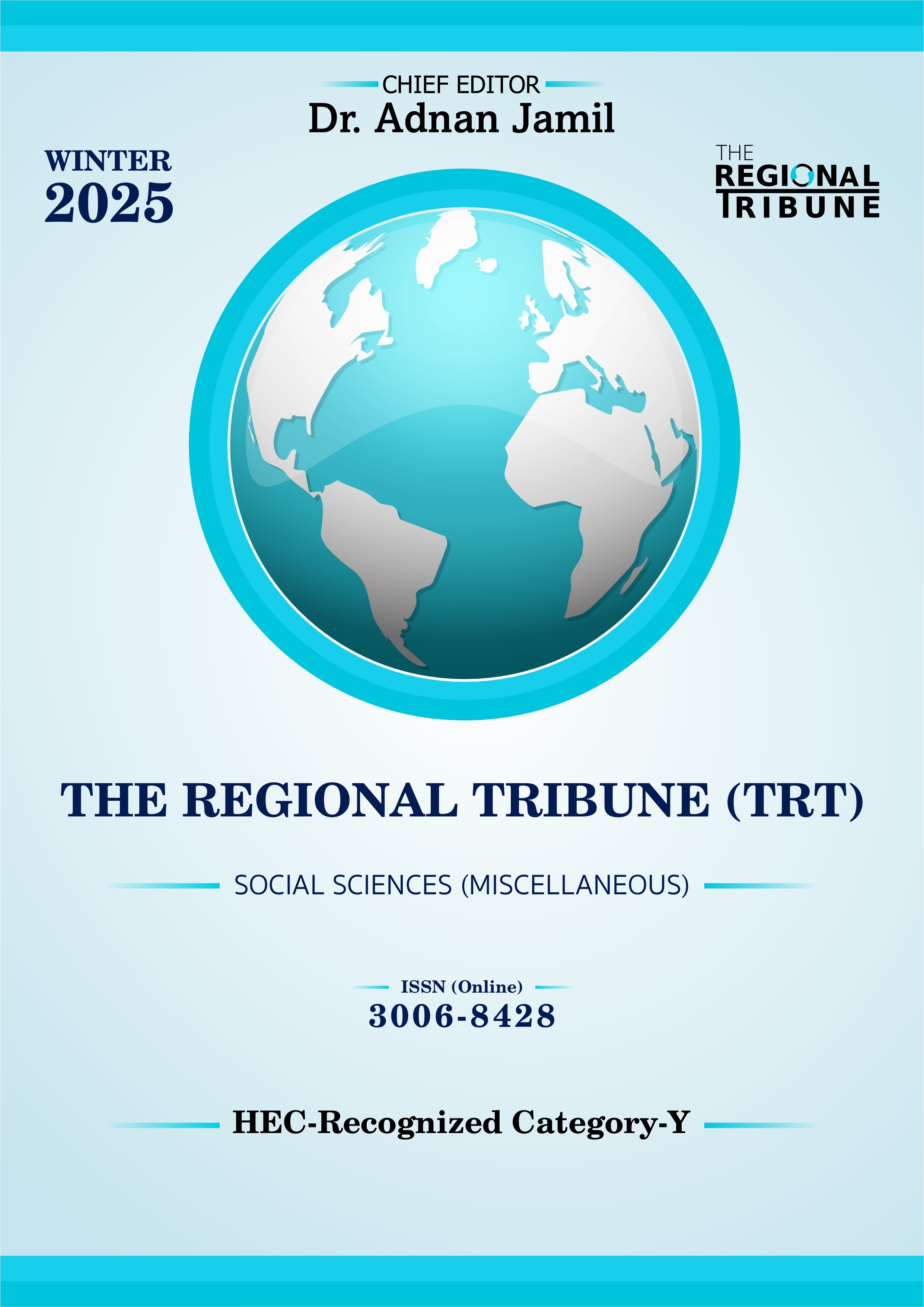Comparative Analysis of Stress Level and Mental Well-Being in Rural and Urban Residents
DOI:
https://doi.org/10.63062/trt/WR25.070Keywords:
Perceived Stress, Mental Wellbeing, Rural, UrbanAbstract
Mental health includes our emotional, psychological, and social well-being. It affects how we think, feel, and act. It also helps to determine how we handle stress. The current study aimed to examine stress levels and mental well-being among rural and urban residents. This study compares stress levels and mental well-being between rural and urban residents, considering socio-demographic factors such as gender, employment, and marital status. A sample of 294 participants (166 rural, 128 urban) was selected through convenient sampling. The Perceived Stress Scale and Psychological Well-being Scale were used to assess mental health outcomes. Statistical analyses included independent sample t-tests and correlation analyses to examine differences and relationships among variables. Findings revealed a negative correlation between stress and mental well-being. Rural residents reported higher mental well-being compared to urban counterparts (t=0.5, p=.01), while urban residents exhibited higher stress levels (t=9.5, p=.01). Gender differences were observed, with rural males and females scoring higher on mental well-being (t=5.7, p=.02) and urban males and females experiencing greater stress (t=9.6, p=.02). Married individuals had higher well-being (t=8.6, p=.02), whereas unmarried individuals higher on stress (t=0.4, p=.02). Employed individuals reporting better well-being (t=0.5, p=.03), while unemployed individuals exhibited higher stress (t=3.5, p=.02). The study highlights the significant impact of residential environment and socio-demographic factors on stress and well-being. These findings emphasize the need for tailored mental health interventions, especially for urban populations experiencing high-stress levels.
References
Birkmann, J., Welle, T., Solecki, W., Lwasa, S., & Garschagen, M. (2016). Boost the resilience of small and mid-sized cities. Nature, 537(7622), 605–608. https://doi.org/10.1038/537605a
Bowler, D. E., Buyung-Ali, L., Knight, T. M., & Pullin, A. S. (2010). Urban greening to cool towns and cities: A systematic review of the empirical evidence. Landscape and urban planning, 97(3), 147-155. https://doi.org/10.1016/j.landurbplan.2010.05.006
Bulkeley, H. (2013). Cities and climate change. Routledge.
Cohen, A. N., Hammen, C., Henry, R. M., & Daley, S. E. (2004). Effects of stress and social support on recurrence in bipolar disorder. Journal of Affective Disorders, 82(1), 143-147. https://doi.org/10.1016/j.jad.2003.10.008
Diener, E., Suh, E. M., Lucas, R. E., & Smith, H. L. (2007). Subjective well-being: Three decades of progress. Psychological Bulletin, 125(2), 276–302. https://doi.org/10.1037/0033-2909.125.2.276
Dong, K., Sun, R., & Dong, X. (2018). CO2 emissions, natural gas, and renewables, economic growth: assessing the evidence from China. Science of the Total Environment, 640, 293-302. https://doi.org/10.1016/j.scitotenv.2018.05.322
Evans, G. W. (2013). The built environment and mental health. Journal of Urban Health, 80(4), 536–555. https://doi.org/10.1093/jurban/jtg063
Gellis, Z. D., Kim, J., & Hwang, S. C. (2004). New York State case manager survey: urban and rural differences in job activities, job stress, and job satisfaction. The Journal of Behavioral Health Services & Research, 31, 430-440. https://link.springer.com/article/10.1007/BF02287694
Gessert, C. E., Waring, S. C., Bailey-Davis, L., VanWormer, J. J., & Roberts, M. E. (2018). Rural-urban differences in mental health. Journal of Rural Mental Health, 42(3–4), 222–233. https://doi.org/10.1037/rmh0000092
Hong, J., McArthur, D. P., & Livingston, M. (2019). Can Accessing the Internet while Travelling Encourage Commuters to Use Public Transport Regardless of Their Attitude? Sustainability, 11(12), 3281. https://doi.org/10.3390/su11123281
Imaiso, J., & Yamauchi, T. (2009). Caregiver suctioning education for Japanese patients with an invasive home ventilator. Nursing & Health Sciences, 11(4), 422-429. https://doi.org/10.1111/j.1442-2018.2009.00469.x
Khan, S. (2023). Urbanization and mental health: exploring the relationship in developing cities. Social Science Review Archives, 1(2), 105-112. https://policyjournalofms.com/index.php/6/article/view/15
Kim, J., Lee, C., & Sohn, W. (2018). Urban green space and stress: The mediating role of social support. Health & Place, 52, 123–130. https://doi.org/10.1016/j.healthplace.2018.04.002
Luo, Y., Zhou, L., & Zhang, J. (2018). Urbanization and mental health: A longitudinal analysis of stress and depression. Social Science & Medicine, 210, 19–27. https://doi.org/10.1016/j.socscimed.2018.04.020
Lupien, S. J., McEwen, B. S., Gunnar, M. R., & Heim, C. (2007). Effects of stress throughout the lifespan on the brain, behavior, and cognition. Nature Reviews Neuroscience, 10(6), 434–445. https://doi.org/10.1038/nrn2639
Lyubomirsky, S., King, L., & Diener, E. (2005). The benefits of frequent positive affect: Does happiness lead to success? Psychological bulletin, 131(6), 803. https://psycnet.apa.org/buy/2005-15687-001
Marotz, M. K. (1986). Assessing perceived stress across different cultures: A validation of the Perceived Stress Scale. International Journal of Psychological Studies, 14(1), 32–45. https://doi.org/10.5539/ijps.v14n1p32
Mumford, D. B., Minhas, F. A., Akhtar, I., Akhter, S., & Mubbashar, M. H. (2000). Stress and psychiatric disorder in urban Rawalpindi: community survey. The British Journal of Psychiatry, 177(6), 557-562. https://doi.org/10.1192/bjp.177.6.557
Nepomuceno, M. R., Seligman, M. E. P., & Alkire, S. (2015). The role of social connections in mental health: A review of the evidence. Journal of Community Psychology, 43(7), 795-809. https://doi.org/10.1002/jcop.21743
Paul, K. I., & Moser, K. (2009). Unemployment impairs mental health: Meta-analyses. Journal of Vocational Behavior, 74(3), 264–282. https://doi.org/10.1016/j.jvb.2009.01.001
Robles, T. F., Slatcher, R. B., Trombello, J. M., & McGinn, M. M. (2014). Marital quality and health: A meta-analytic review. Psychological Bulletin, 140(1), 140–187. https://doi.org/10.1037/a0031859
Ryff, C. D. (2013). Psychological well-being revisited: Advances in the science and practice of eudaimonia. Psychotherapy and Psychosomatics, 83(1), 10–28. https://doi.org/10.1159/000138652
Seligman, A. A. (2012). Understanding trauma and supporting resilience with LGBT people of color. In K. L. Eckstrand & J. Potter (Eds.), Trauma, resilience, and health promotion in LGBT patients: What every healthcare provider should know (pp. 113–119). Springer. https://link.springer.com/chapter/10.1007/978-3-319-54509-7_10
Smith, R. D., Jones, P., & Brown, C. (2020). Urban stress and resilience: Examining the link between city environments and mental health. Journal of Urban Studies, 57(4), 987–1005. https://doi.org/10.1177/0042098019887421
Stoltz, J., & Grahn, P. (2021). Perceived sensory dimensions: An evidence-based approach to greenspace aesthetics. Urban Forestry & Urban Greening, 59, 126989. https://doi.org/10.1016/j.ufug.2021.126989
Umberson, D., Crosnoe, R., & Reczek, C. (2010). Social relationships and health behavior across the life course. Annual Review of Sociology, 36, 139–157. https://doi.org/10.1146/annurev-soc-070308-120011
Downloads
Published
Issue
Section
License
Copyright (c) 2025 Aina Sabir, Dr. Asma Sikandar, Noshaba Ajaz

This work is licensed under a Creative Commons Attribution-NonCommercial 4.0 International License.



